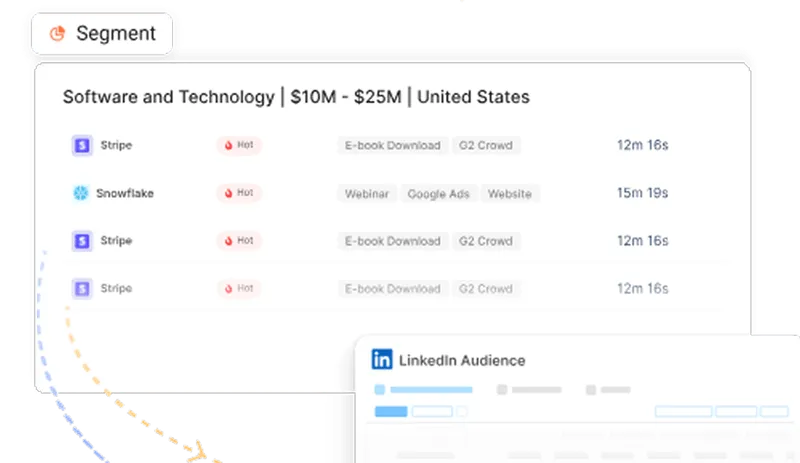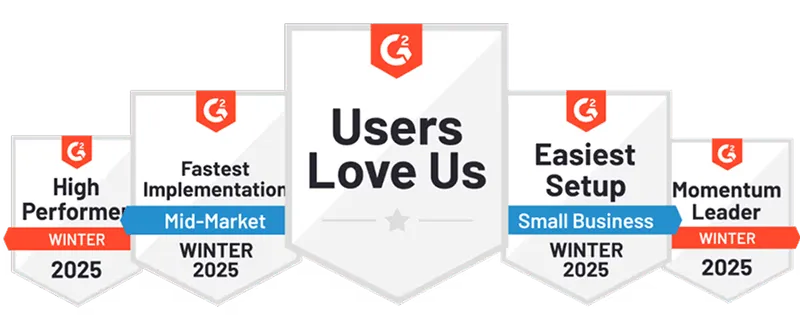B2B Marketing Solutions: A Complete Guide to Strategy & Implementation
Learn how to select, implement, and optimize B2B marketing solutions. Discover proven strategies for aligning tools with business goals and measuring ROI.
Marketing leaders often face a gap between the promises of B2B marketing solutions and their actual impact. Without a clear ROI, investing in new tools and campaigns can drain budgets, miss revenue targets, and create tension among sales, marketing, and executives. Stakeholders expect concrete proof that every dollar spent drives growth.
The solution lies in a systematic approach to selecting and utilizing the right B2B marketing solutions. By aligning choices with business goals, creating a clear plan, and leveraging analytics at every stage, you can find the right solutions and enhance campaigns to achieve steady growth and demonstrate real value to your organization.
Let’s delve into the essentials of B2B marketing solutions.
TL;DR
- Define clear business goals and audit your tech stack to identify gaps and prevent redundancy.
- Foster cross-functional collaboration and choose solutions that are compatible with existing systems.
- Develop a SMART KPI-driven roadmap with channel-specific strategies and agile performance reviews.
- Integrate analytics for a unified customer view and execute targeted, automated campaigns with ongoing testing and refinement.
How to Select the Right B2B Marketing Solutions?
Follow this structured process to choose tools that drive real impact, boost your pipeline, improve efficiency, and prove ROI.
- Define Goals and KPIs: Begin by identifying what you want to achieve, whether it's improving lead quality, increasing conversion rates, enhancing customer retention, or scaling ABM efforts. Align solution selection with long-term business KPIs and growth targets.
- Audit Existing Marketing Stack: Evaluate current tools, workflows, and data systems. Where are the bottlenecks in lead scoring, personalization, and attribution? Clarify what’s missing, duplicated, or underperforming to avoid redundancy and reduce tech bloat.
- Engage Cross-Functional Stakeholders: Involve cross-functional teams like marketing, sales, operations, and IT. Gather pain points and adoption requirements to provide new solutions to solve real problems.
- Prioritize Integration and Compatibility: Select tools that integrate seamlessly with your existing stack, including CRM, CMS, CDP, analytics, and ad platforms. Look for API-first products or native integrations that support your existing ecosystem (e.g., Salesforce, HubSpot).
- Assess Usability & Onboarding: A powerful tool with a steep learning curve can slow teams down. Evaluate UI/UX, documentation, and training resources. Ensure non-technical users can self-serve or automate workflows with minimal support.
- Request Demos and Review Case Studies: Evaluate vendors by requesting live demos tailored to your use case. Study case studies from companies of similar size or industry to validate real-world results.
- Evaluate Scalability and Future Needs: Select solutions that can grow with your team and data volume. Prefer modular tools that allow you to expand usage, add new functions, or support additional users and regions without requiring replatforming.
- Consider Total Cost of Ownership (TCO): Include onboarding, integrations, training, data migration, and support costs. Determine ROI potential through performance metrics, such as increased MQLs or reduced CAC.
- Validate Security and Compliance: Evaluate each tool’s compliance with relevant regulations, including GDPR, SOC 2, HIPAA, and others. Confirm that your company retains data ownership and can export/import easily.
- Start with a Pilot or Trial Implementation: Run a short-term pilot with a defined use case to validate fit. Track performance metrics, user feedback, and integration friction to inform your final decision.
How to Build a Strategic B2B Marketing Implementation Plan?
Follow these steps to create a clear, actionable roadmap that aligns your teams, maximizes resources, and drives measurable results:
- Audit Your Existing Marketing Performance: Start with a thorough evaluation of your current marketing efforts. Utilize analytics tools (such as GA4, HubSpot, or Factors) to pinpoint high-performing channels, identify underperforming tactics, and track overall ROI trends. Look at metrics like lead quality, funnel drop-off points, conversion rates, and campaign attribution.
- Define Clear Goals and KPIs: Set SMART goals (Specific, Measurable, Achievable, Relevant, Time-bound) that align with broader business objectives. Example KPIs might include MQL volume, sales pipeline growth, lead-to-close rate, or cost per acquisition. These will serve as your guiding benchmarks.
- Map the Buyer’s Journey and Audience Needs: Understand your target audience by mapping their journey across stages, such as awareness, consideration, decision, and post-sale. Align messaging, content, and campaigns to meet their needs at each stage. Use personas, firmographics, and intent data for precision.
- Prioritize High-Impact Tactics Based on Resources: Not all campaigns carry equal weight. Focus on revenue-generating tactics like ABM, paid retargeting, or email nurtures that support sales goals. Budget wisely, allocate more to what converts, and use pilot tests for newer channels before full deployment.
- Create a Channel-Specific Content Strategy: Develop tailored content formats and themes for each key channel (e.g., webinars for mid-funnel education, LinkedIn ads for awareness, whitepapers for lead gen). Ensure messaging consistency and a strong value proposition across touchpoints.
- Build a Detailed Marketing Calendar: Plan campaign timelines, content releases, webinars, product launches, and ad cycles in a centralized calendar. Tools like Asana, Notion, or Trello help manage execution and avoid overlaps or missed opportunities.
- Document Roles, Responsibilities, and Workflows: Ensure alignment across marketing, sales, content, and ops. Define who owns each campaign, who’s responsible for reporting, and how leads are handed off between teams. Use tools like RACI matrices for clarity.
- Monitor and Optimize in Real Time: Don’t set and forget. Review campaign performance weekly or monthly. Use dashboards to surface actionable insights. Pivot quickly, optimize budgets, adjust messaging, or pause ineffective campaigns based on data.
- Plan for Flexibility and Market Agility: Build flexibility into your plan to accommodate market shifts, emerging trends, or product changes. Revisit your strategy quarterly to refine it based on competitive shifts, buyer behavior, and feedback from frontline teams.
This approach creates a clear roadmap that aligns your team, optimizes resource use, and enhances the likelihood of achieving your B2B marketing goals.
How to Develop an Execution Roadmap for B2B Marketing Solutions
- Break Down Strategy into Actionable Milestones: Translate high-level goals into specific initiatives. For each initiative (e.g., launching an ABM campaign), define milestones (e.g., account selection, creative development, campaign launch) and assign owners to ensure accountability.
- Create a 90-Day Action Plan: Develop rolling quarterly plans that include detailed tasks, responsible parties, timelines, and resource requirements. This enables agile execution and allows for re-prioritization based on new insights or market shifts.
- Assign Clear Roles and Responsibilities: Use a RACI model (Responsible, Accountable, Consulted, Informed) to clarify who owns each task and who needs to be involved. This prevents duplication of effort and ensures faster progress.
- Establish Governance and Feedback Loops: Establish a regular review cadence.
- Weekly check-ins for task progress and blockers.
- Monthly reviews for assessing campaign performance.
- Quarterly reviews to evaluate broader outcomes and strategy fit.
- Use Real-Time Dashboards and Customer Feedback: Track KPIs like conversion rates, pipeline contribution, and engagement using dashboards. Complement this with sales and customer feedback to refine messaging, channels, and offers.
- Document Assumptions and Decision Rights: Clearly outline key assumptions (e.g., buyer persona needs, budget expectations) and identify who has the authority to make which decisions. This helps your team stay agile without getting stuck on approvals.
- Prepare for Course Corrections: Build Flexibility into your roadmap. Include checkpoints to assess whether priorities need to be shifted due to competitor actions, campaign underperformance, or internal strategy changes.
This structured approach connects strategy with daily operations, resulting in a more agile and effective B2B marketing program that delivers measurable results.
How to Integrate B2B Marketing Analytics?
Integrating analytics into your B2B marketing is crucial for informed decision-making and campaign enhancement. Here’s how you can do it:
- Set Up Comprehensive Data Collection: Start by integrating data from all major sources, including your CRM (such as Salesforce or HubSpot), marketing automation platforms, advertising channels (e.g., Google Ads, LinkedIn), and website analytics (e.g., GA4, Factors). This ensures end-to-end visibility into user behavior and campaign performance.
- Consolidate Data for a Unified View: Use a data warehouse or a customer data platform (CDP) to centralize data. This helps eliminate silos and provides a 360° view of prospects and customers across touchpoints.
- Define Clear Measurement Objectives: These KPIs guide performance reviews and strategic decisions. Align your analytics with specific business goals, such as:
- Qualified leads generated
- Website conversion rates
- Pipeline velocity
- Customer acquisition cost (CAC)
- Revenue attribution
- Deploy Visualization & Reporting Tools: Utilize tools like Google Data Studio, Tableau, or Looker to create interactive dashboards that provide real-time insights. Customize views for marketing, sales, and executive stakeholders.
- Apply Attribution Modeling: Select attribution models, such as first-touch, last-touch, linear, or data-driven, based on the complexity of your sales cycle. These models help identify which channels and touchpoints are most influential in driving conversions.
- Ensure Ongoing Accuracy and Relevance: Regularly audit your tracking setup (e.g., UTMs, tags, API syncs) to avoid data loss or inconsistencies. Update dashboards as metrics evolve or new tools are integrated into your stack.
- Turn Insights into Action: Use analytics not just for reporting but to iterate quickly: refine targeting, adjust budget allocations, test content strategies, and align with sales enablement priorities.
By integrating analytics at every stage, you empower your marketing and sales teams to make informed decisions, enhance ROI, and continuously improve your B2B marketing for sustained growth.
How to Execute B2B Marketing Campaigns?
You can execute a strategic B2B marketing campaign by:
- Map Content to the Buyer’s Journey: Structure your campaign around the three core stages:
- Awareness: Utilize blogs, infographics, and social media ads to educate and capture attention.
- Consideration: Offer case studies, comparison guides, and webinars to build trust.
- Decision: Provide ROI calculators, product demos, and tailored proposals to drive action.
- Choose the Right Channels for Your Audience: Identify where your target audience spends their time and focus your efforts there.
- LinkedIn: Great for ABM and professional engagement.
- Email: Ideal for nurturing leads and personalization.
- Search & Display Ads: For capturing high-intent demand.
- Industry Events & Webinars: For building authority and deeper engagement.
- Maintain Consistent Messaging Across All Touchpoints: Ensure your value proposition is communicated on all platforms, whether it's a sales email, landing page, or social post. Consistency boosts brand recognition and trust.
- Use Marketing Automation for Scale & Precision: Platforms like HubSpot, Marketo, or Pardot allow you to:
- Automate lead-nurturing workflows.
- Score leads based on behavior.
- Trigger personalized messages in real time.
- A/B test creatives and sequences.
- Track and Analyze Campaign Performance in Real Time: Monitor key metrics like:
- Conversion rate by channel and content type.
- Cost per lead (CPL) and customer acquisition cost (CAC).
- Engagement metrics, such as open rates, CTRs, and session duration.
- Run Continuous Optimization Loops: Use testing and analytics to improve campaign outcomes:
- A/B test subject lines, CTAs, landing pages, and visuals.
- Adjust targeting and bidding strategies based on performance.
- Retarget engaged users to move them down the funnel.
- Align Sales and Marketing During Campaigns: Share campaign insights with sales teams in real-time. Use shared dashboards, lead scoring, and feedback loops to improve follow-up quality and timing.
B2B Marketing Solution: Aligning Strategy, Planning, and Execution
Aligning strategy, planning, and execution is essential for B2B marketing success. Ensure all teams understand business goals and hold regular meetings to maintain alignment among marketing, sales, and operations. Clearly define roles to ensure everyone knows their responsibilities.
Break projects into smaller tasks with clear deadlines, using tools to track progress and ensure accountability. Document deliverables to avoid confusion and maintain consistency.
Foster open communication to address issues early and adjust plans as needed. Implement regular review cycles, with weekly updates and monthly strategic checks, to identify issues early and allow for quick adjustments.
By promoting collaboration, setting clear expectations, and maintaining transparency, you ensure strategy, planning, and execution work seamlessly to drive B2B marketing success.
Final Thoughts on Implementing B2B Marketing Solutions
Implementing B2B marketing solutions involves more than selecting tools or launching campaigns. It requires creating a system where strategy, planning, and execution harmonize. Begin by understanding your business needs, aligning stakeholders, and setting clear goals to build a strong foundation for success. Develop detailed plans, assign clear roles, and utilize analytics to ensure every action has purpose.
Regular reviews and feedback enable adaptation to changes and alignment with business goals. Avoid common mistakes, such as misaligned priorities or unclear roles, to maximize ROI and achieve growth. Successful B2B marketing teams collaborate across departments, learn from data, and refine their approach. With a disciplined process, your organization can transform marketing plans into tangible results, driving both pipeline and revenue growth.
See how Factors can 2x your ROI
Boost your LinkedIn ROI in no time using data-driven insights


See Factors in action.
Schedule a personalized demo or sign up to get started for free
LinkedIn Marketing Partner
GDPR & SOC2 Type II
.svg)









